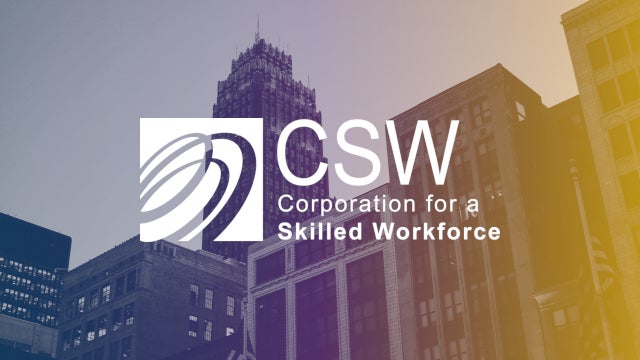Company
Wegmans Food Markets
Upskilling program name
Hillside Work-Scholarship Connection (HW-SC)
Program goal(s)
At Wegmans we aim to contribute to our communities and serve our customers by encouraging a vibrant, healthy and educated workforce. Our program goals are to excel at recruitment, retention, growth of our talent pipeline and the diversification of our management pool. With the Hillside Work-Scholarship Connection program, we insure that our young people have a positive attitude, are responsible, can work on teams, make good decisions, and are attentive to our customers. We take a holistic approach in order to impact our future workforce by focusing on talent development at an early stage in a positive way.
Who provides the program services (in-house, outside provider, etc.)?
Founded in 1987, Wegmans first ran the program as a voluntary effort administered by staff and managers. By 1991 the program was extremely successful and was awarded the President George Bush “Points of Light” award, was adopted and endorsed by the National Center on Education and the Economy, and studied by the Food Marketing Institute as well as Harvard University. Because of the incredible success and need for growth, we initiated a community-wide RFP and transferred program operations to our non-profit partner.
The program is now a partnership between a non-profit provider Hillside Work-Scholarship Connection, the local school districts and several employer partners across New York and it the National Capital Region. Wegmans remains the largest employer partner with nearly 600 students employed.
If outside providers, please list key partners.
Hillside Work Scholarship Connection, a not for profit affiliate of Hillside Family of Agencies is our main partner. This community non-profit operates the $15 Million operation which has now grown to serve more than 4000 students and boasts over 5000 alumni. Other partners include 7 school districts across New York State, two districts in the National Capital Region, a variety of charter schools and over three dozen local, regional, and national employer partners. Other partners include states and municipalities, local United Ways, private funders, and several colleges and community colleges offering scholarships.
Who is the program is designed to assist?
Hillside Work-Scholarship Connection is designed to assist at-risk youth living in poverty to stay in school, graduate from high school, and progress to post-secondary education and/or employment.
The program is aimed at first time workers. With over one-third of our workforce under 21, we have seen an increasing lack of preparation in the workforce particularly in urban high schools where the graduation rate hovers around 50%. Low graduation rates contribute to a cycle of income inequality and poverty and a shortage of workers. We strive to hire students who face barriers to economic opportunity and success.
Who is eligible for the program?
Students are eligible for the program if they are enrolled in a participating school district, are in grades 7-12 and have two or more research based risk factors for school dropout including:
- Meeting federal poverty guidelines
- Failing two or three core subjects
- Low standardized test scores
- Low school attendance rates
- Multiple school suspensions, and
- Being over-age for their grade level
The majority of students – 97% live in poverty and 83% have low standardized test scores. Of the thousands of students served, all have 2 or more risk factors. 56% of students had a combination of Low Socioeconomic Status and Low Standardized Test Scores. Eighty-eight percent of our students are visible minorities.
How is the program funded (i.e., company/participant share; prepaid by company vs. individual reimbursement; etc.)?
As part of normal company operations we support the payroll for the students as well as the integrated support positions. We also support the program through our company sponsored college scholarship program which to date has granted $90,000,000 over the past 30 years to 30,000 scholarship winners.
The majority of the direct program costs are borne by the non-profit partner. The funding model is a public-private partnership whereby the school district is responsible for providing half of the budget and the remaining funding is leveraged through philanthropic support. Wegmans Family Foundation is a significant investor in the program.
Is there an annual or lifetime cap on the program benefits?
No
Do employees get paid time off to participate or are they in any way compensated for their participation?
This program is fully integrated into our corporate culture. We have true organizational buy-in and commitment to supporting the students from the C-suite all the way to our front end managers. It is part of the day-to-day work of store and corporate operations and therefore the standard compensation and PTO structure encompasses support of this program.
What is your participation goal, and what actions are you taking to reach that goal?
Each year we strive to achieve a baseline number of employed students in each region. We strive to keep our turnover low – under 30% for minors. We expect 100% of eligible employed program students will apply for the company-wide college scholarship program.
To reach our goals we insure that all program employees are immediately oriented to our values. We hold each program enrollee to the same set of standards and accountability as any other employee. We teach them incredible customer service, flex to their needs and schedules, reward them with increasing pay and more responsibility, and we support their pursuit of high school graduation and a college degree with scholarship incentives.
What, if any, supports do you have in place to ensure participants complete the program?
We believe that there are four key components that insure participant success:
- A trusted caring adult that provides mentoring and support at home, school and on the job
- Job readiness training and job placement (25 hours training on soft skills, interviewing techniques,
resume writing) - Tutoring and College Preparation Services
- College Scholarships
We support the program and students from all angles with buy-in that is saturated throughout all levels of the organization. We have program champions at each store and program buy in throughout employee relations, as well as the front end management and senior leadership.
What data are you collecting/tracking?
We are committed to resourcing and tracking the following activities:
- Identify internal company champion(s) and point of contact
- Communicate any issues as they arise
- Support student schedules 15-20 hours/week and adjust as necessary to support student goals
- Provide an on-site mentor and training
- Ensure that the work environment is youth-friendly
- Share career pathway opportunities and guidance
- Review employment and academic performance with Youth Advocates
- Adhere to Minor Labor Laws, all state and federal employment/workplace requirements
Our partner agency key measures include:
- Graduation Rates
- Grade Promotion Rates
- Employment Attainment
How do you measure or plan to measure the benefits the program brings to the company?
After 30 years the benefits to the company are deeply imbedded in our culture. We are confident that this program contributes to our ability to make the Fortune’s list of Best Places to Work each year. In 2017 we achieved #2 on that list.
We measure several key components relating to business success and have found that the program helps to:
- Increase employee retention and diversity
- Enhance the customer experience through skilled and knowledgeable employees
- Realize operational cost savings through aligned philanthropy and corporate goals
- Further advance community relations efforts around education and workforce development
Most impressive is the fact that employed program students graduate at 96% – these are the students who entered the program with a high likelihood of dropping out.
What results have you seen to date?
This program has had an enormous impact on our corporate culture. We have seen dramatic changes in our recruitment and retention efficiencies, we have a strong internal talent pipeline and we continue to have excellent customer service.
In hindsight, what is the best decision you made in setting up this program?
The best decision was to outsource the program to our not-for-profit community partner who works in partnership with us ensure student success.
What, if any, changes have you made in the program since its introduction? Why were these changes made?
We reformatted our front-end operations, and created a service team leader who advocates for the 30 people assigned to them. No matter when an employee is working, they now have a direct line of support outside of their front-end reporting structure. Our non-profit partner provides the entry level Youth Employment Training so each new hire is trained on customer service needs prior to hire. We provide employee driven scheduling and align shifts to help match our transportation and school based support. We also provide mentoring, educational assistance and a variety of opportunities for career advancement.
What advice would you give those considering a similar project?
Our advice to others is to be patient, work together, and focus on the employee and student success and not on the bottom line. Put people first and the bottom line will follow.



